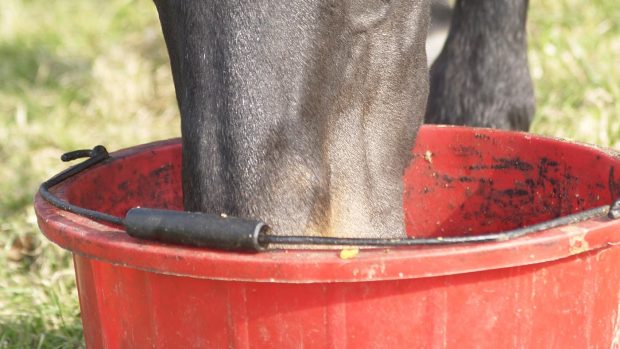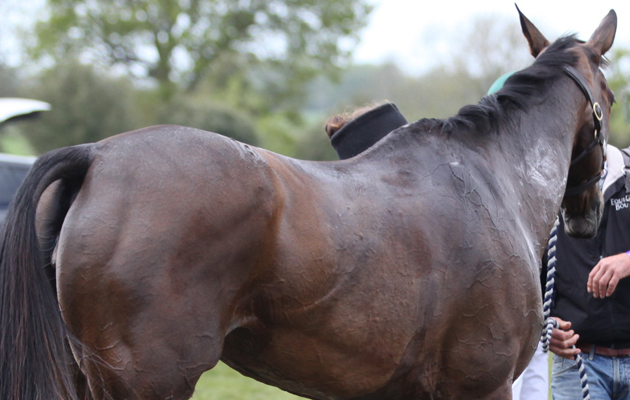Major competitions in challenging climates, such as the Olympics in Atlanta, have made everyone well aware that sport horses can be exercise-intolerant when placed in a hot environment without the chance to become acclimatised.
On a lesser scale, this is a concern if there is a heat wave in this country. If it is unusually hot and humid, exercising horses will find it harder than normal to cool down as they work. High humidity prevents the efficient evaporation of sweat and its associated body cooling. Any horse who is unacclimatised to the heat will sweat more, as will any animal that is unfit, overweight, or has a thick coat.
Even a fit horse can produce vast amounts of sweat. It is said that a racehorse running one mile in approximately two minutes will produce more than two gallons (literally a big bucket’s worth) of sweat.
As a horse sweats, it loses water and electrolytes (body salts). The key electrolytes are sodium chloride and potassium, with smaller amounts of calcium and magnesium. Bicarbonates, phosphates and sulphates also have electrolyte roles. All these compounds have vital roles in maintaining the skeleton, making muscles work and converting energy within the body.
A horse’s sweat is hypertonic, which means it contains a higher concentration of salts than blood does. If both water and electrolytes are lost and not replaced, the animal will become dehydrated and its performance will be affected.
Electrolyte loss can result in conditions such as thumps, properly called asynchronous diaphragmatic flutter. This is a little like hiccups in that the horse’s flank twitches and it makes an audible thump, hence the name. It is not really harmful in itself, but is alarming for the rider and indicates that a severe electrolyte disturbance is present.
Serious electrolyte disturbances can result in muscle disorders, such as azoturia (tying up), which can cause a horse to collapse. There is also an alarming syndrome of heat stroke and dehydration, often lumped together as “the exhausted horse complex”, which is the great fear for anyone competing a horse in hot, humid conditions.
Water is absolutely essential: no living organism can survive without it. A horse’s body is nearly 70% water, most of which is concentrated in the individual cells of the body and as a key component of blood. The horse’s gut, particularly the large intestine, acts as a fluid reservoir and may hold as much as 60 litres of water.
Generally, a horse will drink more water than it needs. Exactly how much water a horse drinks per day depends on the moisture content of the feed it eats, the work it is doing and the climatic conditions. In hot, humid conditions, when dehydration is a risk, a horse will need to increase its water intake at least fourfold.
Traditionally, dehydration is checked by the skin pinch test. In a normally hydrated horse, the skin will ping rapidly back into place. A seriously dehydrated horse will have a small residual fold of skin left for longer than might be expected. However, this test can be confusing and inaccurate, particularly as the elasticity of skin varies. Performance may be affected below the level that a skin pinch test would detect, so it cannot be relied on without assessing other signs.
Other clues include dry or tacky gums and in severe cases, a weak, fast pulse, sunken eyes and cool extremities. It may not be that obvious that there is a problem, especially as dehydrated horses have been shown to sweat less than normal animals.
The golden rule is to replace fluid and electrolytes at every opportunity. It is advisable to allow frequent small drinks when exercising, and wrong to withhold water before competing.
Water and electrolytes are normally replenished by a horse’s normal diet, but there may not the opportunity to do this in a lengthy competition situation. Water alone will not provide rapid rehydration as electrolytes, particularly sodium, are needed. Only offering water may dilute the body fluids and disturb the electrolyte balance further.
To prevent this imbalance, there are a variety of commercially available equine oral replacement solutions. It is important that there are made up at the correct concentration and even more crucial that your horse will take them.
Adding electrolytes to drinking water can cause a reduction in water consumption. Adding apple squash or juice can mask the taste of salts in water, whilst some competitors use applesauce to make palatable electrolyte pastes. If horses are trained to this before a competition, they should take it readily when they need salt supplementation.
It is impossible for a horse to store extra electrolytes for future needs, so there is little point in giving extra electrolytes on a regular basis except to get him used to the taste. Under normal conditions, an adult horse on a good diet will receive enough electrolytes.
Horses who sweat excessively may need additional salt added at approximately 1% of the daily ration. It is usually sufficient to give an electrolyte supplement as soon as possible after major exertion that includes sweating.
|
||
 |
||


 Get up to 19 issues FREE
Get up to 19 issues FREE TO SUBSCRIBE
TO SUBSCRIBE 


